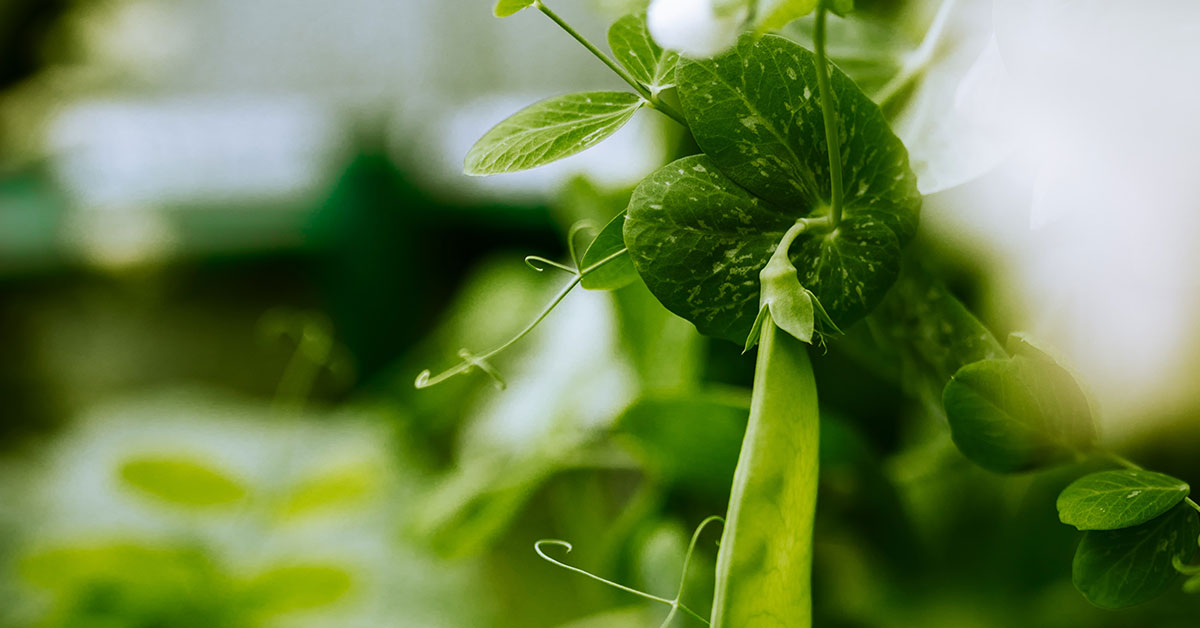Peas are a popular vegetable for gardeners in no small part because they are planted very early in the growing season and harvest early – before the heat of the summer really sets in. But did you know that you can usually grow two crops of peas in a single year? Say hello to fall peas! Growing fall peas is about as easy as springtime peas, but your timing has to be pretty spot on.
In this article, we’ll tell you what you need to know about growing and harvesting fall peas.
Growing Fall Peas
The same fundamentals for growing peas in the spring apply to fall peas as well, but the timing is different and in some ways, a little bit harder. To get the most out of our fall pea crop, let’s talk pea fundamentals:
- Latin name: Pisum sativum
- Tenderness: Annual
- Sun: Full sun, 6-8 hours daily
- Water: Thorough water once weekly
- Soil: Fertile, sandy loam
- Start indoors: Mid-summer, June to July
- When to plant: 2 months before first frost
- Spacing: 3 inches
- Plant height: 3-8 feet tall
- Time to maturity: 60 days
- Container friendly: Yes
- Fertilizer: 10-10-10
- Deer resistant: No
- Pest resistant: No
Peas are a picky tender annual vegetable that cannot survive through frost or high temperatures. Plant your peas in fertile, sandy loam soil in an area with full sun. Peas require full sun, a minimum of 6 but preferably closer to 8 hours of direct sunshine a day. Watering peas is pretty simple, just offer a very thorough watering once a week. If your fall peas seem droopy, increase your watering slightly.
Your pea plants should be spaced out about 3 inches and properly supported by a trellis. Bush peas can grow to about 3 feet tall, while some varieties of vining peas can get up to 8 feet tall. They typically will begin producing edible peas at about 60 days. Proper planting timing is vitally important for late season peas. Your peas will need to grow fast and appreciate a balanced 10-10-10 fertilizer. Peas aren’t deer or pest resistant.
When to plant fall peas indoors
Your peas should be planted indoors sometime around mid June to mid July, depending on the average timing of your first frost. Where I live, the first frost can happen anytime after October 11th. Peas should be given 6 to 8 weeks indoors before being planted outdoors. So in my case, I plant my peas indoors during the first week of July at the latest. This gives them a really important head start.
When to plant fall peas outdoors
Using my area as an example, because peas need about 60 days to get to the point where they’re providing a crop, I plant outdoors sometime around the third week of August. From here, they’ll have 60 days of in the ground time before the danger of frost returns on October 11th. You’ll want to do some research on when the average first frost is in your area to determine when to plant your fall peas indoors and outdoors.
Water
Peas need a good amount of water to grow quickly to their full size and produce big, juicy peas. The ideal watering schedule is a thorough watering once a week, soaking the soil deep. Depending on when you plant and what your climate is like, you may want to water them more. In my area, we have very dry, hot Augusts, which is when peas need to be planted outdoors here. I usually offer a thorough watering 2-3 times a week until it cools off.
Sunlight
Your fall peas will require full sun in order to grow properly and produce delicious, healthy peas for you. Full sun is typically a minimum of 6 hours of direct sunlight every day. Ideally, you’ll plant your peas in an area that provides 8 or more hours of full, direct sunlight.
Soil
Your fall peas will do well in a fertile, sandy loam type of soil, but generally aren’t picky as long as there’s a good amount of readily available nitrogen. Some gardeners plant their peas in the same garden beds they planted corn, as corn is a nitrogen fixing plant. Providing some compost or rabbit manure at the time of planting will help your peas thrive.
Fertilizing
Peas need to grow fast in order to produce their pods before the year’s first frost graces your garden. Providing your peas with a balanced 10-10-10 fertilizer or something a little bit more nitrogen heavy will help ensure that your peas are able to grow to full size and produce for you in time. Mulching in some compost or rabbit manure at time of planting can help as well.
Growing Fall Peas in containers
Peas do pretty well when grown in containers. Select a simple vegetable gardening potting soil from your local garden store and supply the occasional 10-10-10 fertilizer and a solid trellis for them to grow up. Just keep your spacing fundamentals the same: about 3 inches spaced between each pea plant in your container.
Common problems
Peas in general are not deer or pest resistant and should be monitored closely for unwanted attention from pests, but the most common problem with fall peas is poorly timed planting. You’ll need to determine when the danger of frost begins in the fall and then plan to plant indoors 6 weeks before planting outdoors, allowing your plants 60 days of being planted in the ground before that first frost date.
As an example, my frost date is October 11th, so I need to have my peas planted outdoors in the ground around August 16th, which means I need to start them indoors around July 5th.
Keep Reading: When To Plant Each Type Of Vegetable




